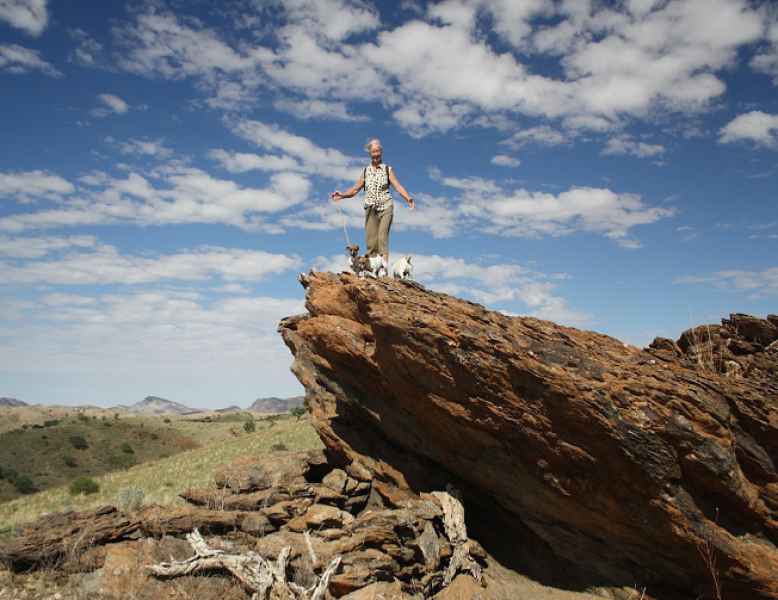Quiver Tree Trail
Trail to a beautiful quiver tree and through a wild rivier back to the farm house.
Time: 2 hours
Description
This two hour walk takes us from the Farm house over the undulating hills and over a small rivier to a beautiful solitary quiver tree (Aloe dichotoma) and through a gorge and a wild river back to the Farm house.
We walk from the Farm house past the factory building in a southerly direction. After about 100 metres we leave the pad and follow the path on the right. This leads us along a hill below the ridge. Follow the path until you reach the Pad again. On the other side of the pad we see a pile of white quartz stones and the sign "Quiver Tree Trail" . We follow the marked path over the ridge of a small hill to a distinctive rock that was used as a shelter by shepherds.
Leave the rock outcrop to the right and follow the path, slightly marked with white stone piles, down into a small gorge where you turn right and follow the marking arrows. Soon the ravine joins a bigger one where we keep right and climb over the polished boulders and stones, avoiding some smaller pools and soon see the impressive quiver tree on the righthand slope. Now we climb the path uphill to this wonderful tree. But careful! Wild bees have their home here, so that we should not get too close. The path turns left at the Aloe. A white arrow points the way. The path is marked by white quartz stone piles. Continue straight ahead along the ridge below the ridge until another arrow after about 200 metres points to the right into a large rivier. At the entrance there is a huge, fallen rock.
In the rivier we turn right and follow its course that takes us back in the direction of the farm. Several caves in the steep bank provide shelter for harmless and not so harmless animals. Everywhere in the sand we might find fresh tracks of zebras, kudus and sometimes from cats and hyenas. Suddenly a big cave with lots of animal bones appears at the right, unmistakable the dining room of a leopard. We should not disturb him and restrict ourselves to inspect the cave from outside. Soon impressive boulders block our way, but we can easily go through the remaining gaps .
We continue for about 100 meters our walk and soon pass a small waterfall with a nice pool, somewhat hidden behind the rock walls. Unfortunately, it runs only after rains.
Shortly thereafter the riverbed widens and on the right a pad leads up the bank.
Shortly after we have reached the top, we recognize the quartz stone pile on the right side with the sign "Quiver Tree Trail", which we followed at the beginning of the hike . Now we follow the pad back to the Farm house .
Back at the Farm house after a great and joyful, but sometimes quite strenuous walk, we relax at the pool or in the shade of the lapa with a cool drink or an ice cold beer or Savanna, reporting our sightings and telling about our experiences on this fantastic trail.
What you should bear in mind on your walk
Before starting your walk you should notify the reception about your intended trail and when you expect to be back. Do not forget to inform the reception after you got back to avoid a possible search. And keep in mind, that there is no cellular reception in most parts of the area.
Never leave the marked path and do not try to shortcut the trail. The terrain with its deeply cut rivers and ravines is confusing and orientation and progress off the trails and pads will be strenuous and difficult. Especially during summer temperatures can be very high. Even in winter temperatures often rise over 30° and there will be almost no shade available on your walk. Always take enough water with you and expect the walk to be strenuous. Pay attention to sufficient sun protection and good footwear.
During the rainy season the rivers can still run, and parts of the trail may be flooded and impassable. Keep this in mind and ask at the reception about the current situation. They will provide you with valuable information and useful hints. On your walk you will most certainly come across some game. Mostly this will be zebras, kudus, oryx or dassis and duikers. Although there are also predators like hyena, rooikat, leopard and even cheetah, they are rather shy and will avoid you. If you are lucky, you will recognize their tracks in the sand. There are also snakes and scorpions, but these too will hardly be seen. Nonetheless, always keep in mind, that you are in a wilderness. Never deliberately disturb the game, do not take or remove stones or plants. Respect nature and walk with open eyes. Leave nothing but your footprints. If you consider this, your walk will be a unique experience.







